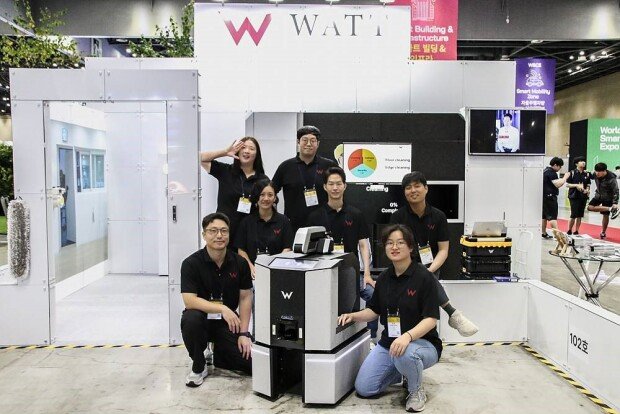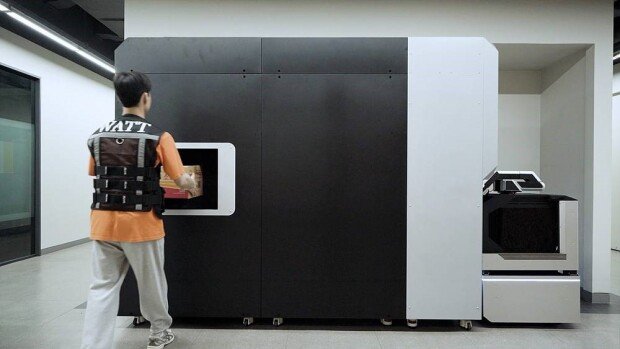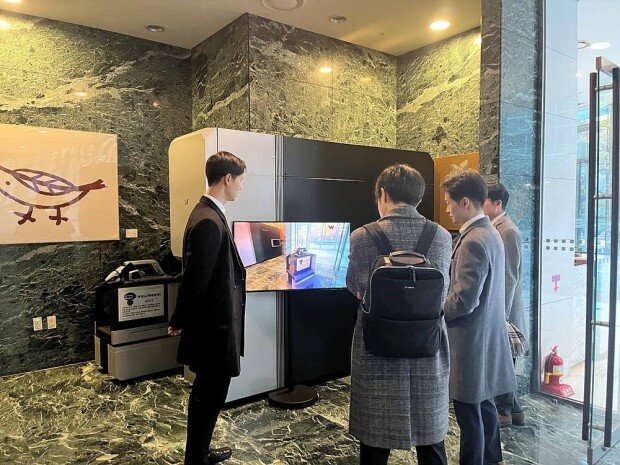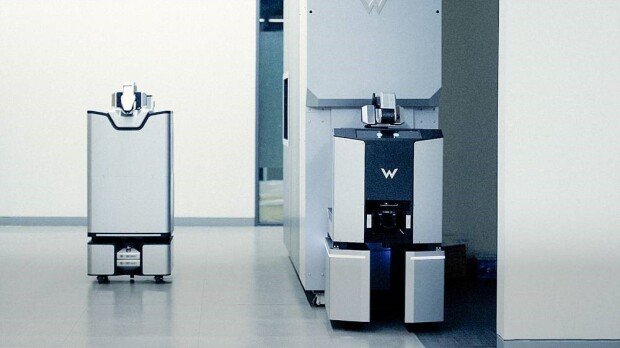WATT: "Pioneering Unmanned Indoor Robot Delivery Systems"
WATT: "Pioneering Unmanned Indoor Robot Delivery Systems"
Posted December. 23, 2024 16:29,
Updated December. 23, 2024 16:29
Robots excel at performing tasks faster and more accurately than humans, and can operating safely around the clock. As a result, they have become integral to industries like manufacturing, logistics, facility inspection, and food preparation. However, their adoption has been limited in some sectors where robots lack the necessary sophistication for the tasks, or when the total costs from development to mass production outweigh their utility.
Industries have thus adopted a strategy of focusing on the sectors in which robots can be most effective, concentrating their resources on developing highly specialized robots for targeted tasks. Instead of building all-purpose robots, they are creating robots designed for specific functions. This approach reduces development and implementation costs while improving efficiency. WATT, a startup led by CEO Jaewon Choi, has adopted this targeted strategy.
 WATT employees introduce their indoor delivery robot solution, James. / Source: WATT
WATT employees introduce their indoor delivery robot solution, James. / Source: WATT
Jaewon Choi pursued mechanical and electronic engineering through his master's studies. Witnessing the transformative potential of technology, he was inspired to create robots that could solve real problems and resonate with people. Drawing on his experience in manufacturing at a Dockless electric scooter sharing company, Choi co-founded WATT with fellow researchers. Guided by a philosophy of continuous improvement and a willingness to challenge convention, WATT's mission attracted like-minded team members.
WATT’s flagship offering is its “indoor robot delivery solution.” Designed for large buildings like residential complexes, apartments, and office buildings, the solution enables 24-hour unmanned delivery. It combines two components: the unmanned storage robot W Station, and the autonomous delivery robot James.
 W Station / Source: WATT
W Station / Source: WATT
W Station is a stationary robot placed in a designated area to manage and sort packages. When it receives an item, it determines its dimensions and delivery destinations, then sorts it accordingly. Equipped with an internal conveyor belt, it handles heavy items effortlessly.
James is responsible for delivering the packages sorted by W Station to their destinations. Delivery personnel can also manually load items into James and input the desired location. Once it receives a package via the conveyor belt, James determines the floor and specific drop-off point, and navigates there autonomously. It sends notifications to recipients before delivery, and avoids obstacles along the way.
 James presses an elevator button with its robotic arm. / Source: WATT
James presses an elevator button with its robotic arm. / Source: WATT
WATT highlights James’s robotic arm as a key differentiator. Traditional delivery robots communicate with elevators via wireless signals; in underground or high-rise locations, interference is often a factor to contend with. Additionally, such robots cannot access areas with automated doors or keycard systems.
James, on the other hand, physically presses elevator buttons, and can interact with doors or keycard systems using its arm. Its camera ensures precise button identification and operation. Coupled with its advanced spatial awareness, James can adapt to any building’s infrastructure after just two hours of learning.
 W Station and James being tested at a Tower Palace apartment complex. / Source: WATT
W Station and James being tested at a Tower Palace apartment complex. / Source: WATT
Together, W Station and James deliver significant convenience. Operating 24/7, they handle a wide variety of items, including perishable goods, documents, and general parcels. This automation benefits senders, carriers, and recipients by eliminating scheduling conflicts and minimizing the risk of package loss.
WATT’s solution has proven especially useful in secure locations like female-only residences or high-security buildings. With its ability to handle an entire apartment complex’s daily delivery volume, the system demonstrates remarkable efficiency.
 W Station and James undergo trials at the LH Enterprise Support Hub. / Source: WATT
W Station and James undergo trials at the LH Enterprise Support Hub. / Source: WATT
After perfecting its indoor delivery robot solution, WATT conducted successful trials in various locations across South Korea, including large-scale residential complexes, luxury apartment buildings, and commercial office buildings. These trials included package delivery at the TechOne office building in Pangyo, unmanned deliveries at an officetel in Wangsimni, inter-floor deliveries at a prominent apartment complex in Seoul, and dormitory package deliveries at a university.
Having demonstrated the efficiency of its indoor delivery robot solution nationwide, WATT is now turning its attention to Japan. For package deliveries in Japan, including courier services, face-to-face confirmation is mandatory. Delivery personnel and recipients must coordinate in advance to arrange a meeting time, leading to prolonged delivery times and reduced efficiency. WATT’s solution addresses these challenges by reducing the number of building visits required by delivery personnel and allowing recipients to collect their items at their convenience, saving both time and costs.
 W Station and James showcased in Jiwell Homes Wangsimni / Source: WATT
W Station and James showcased in Jiwell Homes Wangsimni / Source: WATT
In its efforts to expand into Japan, Jaewon Choi, CEO of WATT, received invaluable support from the Seoul Business Agency (SBA). Through SBA’s global expansion program, WATT benefited from education on Japan’s startup ecosystem, mentoring, and matchmaking with major Japanese corporations and investors. The program also provided financial support, enabling WATT to introduce its products to a large Japanese real estate company and connect with potential investors. Following successful technology demonstrations with leading Japanese logistics companies, WATT signed an MOU for robot exports and is currently preparing for joint projects slated to begin in 2025.
Despite achievements in developing, producing, and demonstrating its indoor delivery robot solutions and expanding into international markets, CEO Jaewon Choi acknowledges that challenges remain. As WATT develops and manufactures both the hardware and software of its robots in-house, it requires strong technical capabilities and sufficient funding for robot production.
 W Station and James presented in Japan / Source: WATT
W Station and James presented in Japan / Source: WATT
CEO Jaewon Choi remains focused on maintaining WATT’s independence in its robot hardware and software development. While outsourcing production might reduce costs, Choi believes in retaining full control to ensure innovation and supply chain stability.
Following successful trials, WATT plans to finalize its prototypes and start deployment by 2025, aiming to refine delivery data and technology to meet diverse client needs. The company also seeks to establish mass production capabilities to scale up its operations and enhance profitability.
 Jaewon Choi and WATT employees hard at work / Source: WATT
Jaewon Choi and WATT employees hard at work / Source: WATT
Jaewon Choi stated, “The name of the company is a reference to James Watt, whose innovations drove the Industrial Revolution. With integrated hardware, software, and motor technology, WATT aims to revolutionize the delivery robot market. We also plan to introduce advanced dual-arm delivery robots to expand our capabilities and demonstrate the value of robotics in logistics.”
by Joo-kyung Cha (racingcar@itdonga.com)
Industries have thus adopted a strategy of focusing on the sectors in which robots can be most effective, concentrating their resources on developing highly specialized robots for targeted tasks. Instead of building all-purpose robots, they are creating robots designed for specific functions. This approach reduces development and implementation costs while improving efficiency. WATT, a startup led by CEO Jaewon Choi, has adopted this targeted strategy.

Jaewon Choi pursued mechanical and electronic engineering through his master's studies. Witnessing the transformative potential of technology, he was inspired to create robots that could solve real problems and resonate with people. Drawing on his experience in manufacturing at a Dockless electric scooter sharing company, Choi co-founded WATT with fellow researchers. Guided by a philosophy of continuous improvement and a willingness to challenge convention, WATT's mission attracted like-minded team members.
WATT’s flagship offering is its “indoor robot delivery solution.” Designed for large buildings like residential complexes, apartments, and office buildings, the solution enables 24-hour unmanned delivery. It combines two components: the unmanned storage robot W Station, and the autonomous delivery robot James.

W Station is a stationary robot placed in a designated area to manage and sort packages. When it receives an item, it determines its dimensions and delivery destinations, then sorts it accordingly. Equipped with an internal conveyor belt, it handles heavy items effortlessly.
James is responsible for delivering the packages sorted by W Station to their destinations. Delivery personnel can also manually load items into James and input the desired location. Once it receives a package via the conveyor belt, James determines the floor and specific drop-off point, and navigates there autonomously. It sends notifications to recipients before delivery, and avoids obstacles along the way.

WATT highlights James’s robotic arm as a key differentiator. Traditional delivery robots communicate with elevators via wireless signals; in underground or high-rise locations, interference is often a factor to contend with. Additionally, such robots cannot access areas with automated doors or keycard systems.
James, on the other hand, physically presses elevator buttons, and can interact with doors or keycard systems using its arm. Its camera ensures precise button identification and operation. Coupled with its advanced spatial awareness, James can adapt to any building’s infrastructure after just two hours of learning.

Together, W Station and James deliver significant convenience. Operating 24/7, they handle a wide variety of items, including perishable goods, documents, and general parcels. This automation benefits senders, carriers, and recipients by eliminating scheduling conflicts and minimizing the risk of package loss.
WATT’s solution has proven especially useful in secure locations like female-only residences or high-security buildings. With its ability to handle an entire apartment complex’s daily delivery volume, the system demonstrates remarkable efficiency.

After perfecting its indoor delivery robot solution, WATT conducted successful trials in various locations across South Korea, including large-scale residential complexes, luxury apartment buildings, and commercial office buildings. These trials included package delivery at the TechOne office building in Pangyo, unmanned deliveries at an officetel in Wangsimni, inter-floor deliveries at a prominent apartment complex in Seoul, and dormitory package deliveries at a university.
Having demonstrated the efficiency of its indoor delivery robot solution nationwide, WATT is now turning its attention to Japan. For package deliveries in Japan, including courier services, face-to-face confirmation is mandatory. Delivery personnel and recipients must coordinate in advance to arrange a meeting time, leading to prolonged delivery times and reduced efficiency. WATT’s solution addresses these challenges by reducing the number of building visits required by delivery personnel and allowing recipients to collect their items at their convenience, saving both time and costs.

In its efforts to expand into Japan, Jaewon Choi, CEO of WATT, received invaluable support from the Seoul Business Agency (SBA). Through SBA’s global expansion program, WATT benefited from education on Japan’s startup ecosystem, mentoring, and matchmaking with major Japanese corporations and investors. The program also provided financial support, enabling WATT to introduce its products to a large Japanese real estate company and connect with potential investors. Following successful technology demonstrations with leading Japanese logistics companies, WATT signed an MOU for robot exports and is currently preparing for joint projects slated to begin in 2025.
Despite achievements in developing, producing, and demonstrating its indoor delivery robot solutions and expanding into international markets, CEO Jaewon Choi acknowledges that challenges remain. As WATT develops and manufactures both the hardware and software of its robots in-house, it requires strong technical capabilities and sufficient funding for robot production.

CEO Jaewon Choi remains focused on maintaining WATT’s independence in its robot hardware and software development. While outsourcing production might reduce costs, Choi believes in retaining full control to ensure innovation and supply chain stability.
Following successful trials, WATT plans to finalize its prototypes and start deployment by 2025, aiming to refine delivery data and technology to meet diverse client needs. The company also seeks to establish mass production capabilities to scale up its operations and enhance profitability.

Jaewon Choi stated, “The name of the company is a reference to James Watt, whose innovations drove the Industrial Revolution. With integrated hardware, software, and motor technology, WATT aims to revolutionize the delivery robot market. We also plan to introduce advanced dual-arm delivery robots to expand our capabilities and demonstrate the value of robotics in logistics.”
by Joo-kyung Cha (racingcar@itdonga.com)
Headline News
- Acting president fills key court vacancies, opposition cries foul
- Graham Allison raises alarm over 'Thucydides Trap' as U.S.-China tensions rise"
- Samsung posts 6.6 trillion won operating profit in Q1
- Chinese teens caught filming Air Force jets without authorization
- S. Korea’s early presidential election set for June 3






